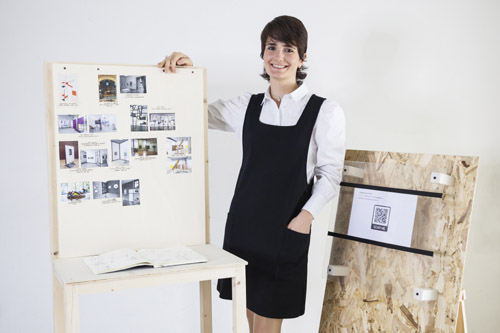The first international biennial dedicated to the photography of Industry and Labour is now in its fifth edition. “FOOD” is the title of “Foto/Industria 2021”, a widespread event, promoted and organized by Fondazione MAST, involving the city of Bologna: eleven exhibitions at ten selected venues are open from 14th October to 28th November. A century of history is retraced through the sensitivity of eleven outstanding photographers, from the 1920s until today.
“The ways in which food is produced, distributed (sold and bought), and consumed – in other words, the mechanisms behind these three crucial steps – are constantly changing, yet always encapsulate certain of the distinctive features of any era, historical period, or cultural and social milieu”, this is what the artistic director Francesco Zanot writes in the introductory text of “Photo book / Cookbook of the Biennale”.
Chocolate and marzipan miniatures acquire real sculptural value in meticulous photographs by Hans Finsler. At the former Church of San Giorgio, an exhibition is dedicated to the photographic project commissioned to the photographer in 1928 by the German confectionery company Most.
In the spaces of Fondazione MAST, an exhibition organized in collaboration with Fototeca Gilardi. Photography as a system of documentation, expression and memory is what emerges from Ando Gilardi‘s photo-investigations made in the 1950s and 1960s and his iconographic collections on the theme of food.
MAMbo Museo d’Arte Moderna Bologna has the opportunity to host Jan Groover‘s first retrospective in Italy. Her background as a painter emerges in the compositional sensitivity applied in the still lifes that made her famous after the 1970s.
Mishka Henner‘s name appears among the main subjects of contemporary “found photography”. The Internet is the resource he draws on for his projects: blow-ups made from Google Earth images, editing of videos found on You Tube, images generated automatically by software.
Two photographic projects covering a period of time between 2000 and 2018. With the “M” series Takashi Homma puts us in front of the ineluctable and, at the same time, disorientating recognizability at the basis of the comfort proposed by the Mc Donald’s chain.Traces of animal blood are the subject of the “Trails” series: ‘signatures’ left by Japanese hunters in the mountains of Hokkaido.
Blood is deeply black, like ink, in the shots of Herbert List, a member of the famous Magnum agency. Forty-one photographs, taken on the Sicilian island of Favignana in the 1950s, document the tuna processing, including the traditional “mattanza”; the photos set up a dialogue with the fresco cycle on the myth of Giasone and Medea in the host hall in Palazzo Fava. Between historical document and artistic work, List’s shots celebrate a popular knowledge destined to disappear.
Valsesian fishing, one of the oldest techniques, becomes a pretext, in Maurizio Montagna‘s research, for investigating the transformations of river landscape in the Valsesia area of Piemonte.
Sixty years of work filtered through the theme of food. French photographer Bernard Plossu takes us around the world without abandoning that curious gaze that emerges in every circumstance.
A multisensory experience presents “Palestine Heirloom Seed Library”: artistic, social and research project that Vivien Sansour started in 2014, in collaboration with Linda Quiquivix, Dalen Saah, Samar Hazboun e Charin Singh. It is an instrument of awareness-raising, through the active involvement of Palestinian citizens and institutions, and of information, for those who learn about the project. The initiative encourages the preservation of ancient seed varieties as living units of history and culture.
Lorenzo Vitturi works on the project “Money Must Be Made”, combining the language of photography with other forms of expression such as sculpture, painting, installation and performance. Long interested in informal economies, Vitturi focuses on the Balogun market in Nigeria, one of the largest street markets in the world.
Henk Wildschut‘s photographic series, commissioned by the Rijksmuseum in Amsterdam, is the result of three years of work dedicated to the theme of the food industry.
Maximising production, hygiene and safety are the key words in today’s food industry. The Dutch photographer’s lens reveals the underlying aspects of the relationship between food and technology.
From technology to tradition, from geopolitical issues to everyday life, a project that does not aim to exhaust such a complex topic as the food question, but to provide a range of diverse case studies.
Eleonora Reffo
Info:
 Henk Wildschut, Swine Innovation Centre (Vic), Sterksel, August 2012 © Henk Wildschut, courtesy MAST Foundation
Henk Wildschut, Swine Innovation Centre (Vic), Sterksel, August 2012 © Henk Wildschut, courtesy MAST Foundation
 Ando Gilardi, Il carro del lattaio con i bidoni pieni, dal fotoservizio Quando il gallo canta a Qualiano. Qualiano (Napoli), Italia, 3 ottobre 1954. © Fototeca Gilardi, courtesy MAST Foundation
Ando Gilardi, Il carro del lattaio con i bidoni pieni, dal fotoservizio Quando il gallo canta a Qualiano. Qualiano (Napoli), Italia, 3 ottobre 1954. © Fototeca Gilardi, courtesy MAST Foundation
 Jan Groover, Untitled, circa 1983 © Musée de l’Elysée, Lausanne – Jan Groover Archive, courtesy MAST Foundation
Jan Groover, Untitled, circa 1983 © Musée de l’Elysée, Lausanne – Jan Groover Archive, courtesy MAST Foundation
 Hans Finsler, Untitled, 1928 Courtesy Fondazione Rolla, Bruzella
Hans Finsler, Untitled, 1928 Courtesy Fondazione Rolla, Bruzella

In 2019 she obtained a BA Degree in Painting and Visual Arts at NABA (Milan), where she is finishing her MA degree in Visual Arts and Curatorial Studies. Since last years she has been collaborating with cultural realities outside the major centres. As curator she is involved in the realization of multidisciplinary projects aimed at heterogeneous audiences.






NO COMMENT